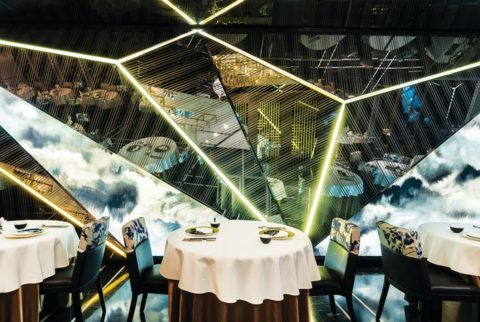One Writer Tries to Eat Her Way Through Hong Kong’s 14,000 Restaurants
The vaguest advice I receive before leaving for Hong Kong is also the soundest: “Eat all the things.” To dine at a different establishment (14,000 at last count) for each meal every day would take more than 14 years, and by then there would be new ones. On Hong Kong Airlines, I get a teaser. For business class, the Vancouver route serves dishes from award-winning Dynasty Seafood, which some say offers the best dim sum outside of China. The daily flight arrives around 5 p.m., just in time for dinner.
On Hong Kong Island, Central is the city’s heart and the obvious place to start exploring. I get my bearings in the most whimsical way: with a morning street-art tour led by Accidental Art. Around corners and down back alleys, Banksy, Shepard Fairey and Invader have left their marks. You feel graffiti’s impermanence most acutely, though, when viewing one of the last remaining calligraphy works by the late Tsang Tsou-choi (a.k.a. “the King of Kowloon”) on Hong Kong’s mainland.

Also in Central, there’s PMQ. Short for “Police Married Quarters,” a nod to the buildings’ past life, it provides affordable studio and retail spaces for local designers. (Other cities, take note.) On the fourth floor of Block A, there’s Central Saint Martins grad Chailie Ho; a whiz with silk, she specializes in scarves and slinky dresses. Across a courtyard, in Block B, Hugo Yeung and Belinda Chang run their jewellery studio, Obellery, showcasing their own works (Yeung favours weighty geometric shapes, while Chang plays a lot with pearls) as well as pieces by local and international artists. Ho, Yeung and Chang also routinely run workshops to share their skills with neophytes. There’s food at PMQ, too, including three bakeries and Michelin-star chef Jason Atherton’s Aberdeen Street Social.
A five-minute stroll down Hollywood Road is Man Mo Temple. Dedicated to the Taoist God of Literature (Man) and the God of War (Mo), it’s especially popular among students—and their parents, hoping for high test scores—but also for anyone looking for respite from the bustle. Incense wafts from all sides, even from above, where coils of it slough off ash like clouds of snow. Those seeking guidance can shake a can of numbered sticks, which correspond to fortunes; throw down a pair of crescent-shaped wooden blocks for answers to simple yes or no questions; or try both, which is what I do because I’m unsure about nearly everything.
Departing from the Tai Po Market rail station, 20 kilometres northwest of Sai Kung, Hong Kong Foodie Tasting Tours guide curious epicureans on progressive meals. The first course is cheong fun, steamed rice noodles that melt in my mouth, at Chan Hon Kee. There’s not much time to walk that off before I arrive at Yat Lok Barbecue Restaurant with its window of glistening roasted geese, which are the thing to try. (Anthony Bourdain’s a fan.) There’s also a place for snake soup, but it’s not in season at the moment, and, admittedly, I’m relieved. Macau-style sweets provide a much-needed palate cleanse before I head to the market complex for deep-fried cuttlefish balls, steamed mullet fish and crab. Consumed on a stool outside as dusk turns to night, a refreshing black sesame tofu dessert from Jiu Guo Xiang Lin caps off my four-hour feast. This is when I learn the most useful Cantonese phrase: ho bau (translation: “very full”).
See Joy Pecknold‘s top five Hong Kong must-eats down below or enter for a chance to win a trip for two to Hong Kong and Thailand valued at $7,500 CAD here.
The post One Writer Tries to Eat Her Way Through Hong Kong’s 14,000 Restaurants appeared first on FASHION Magazine.




